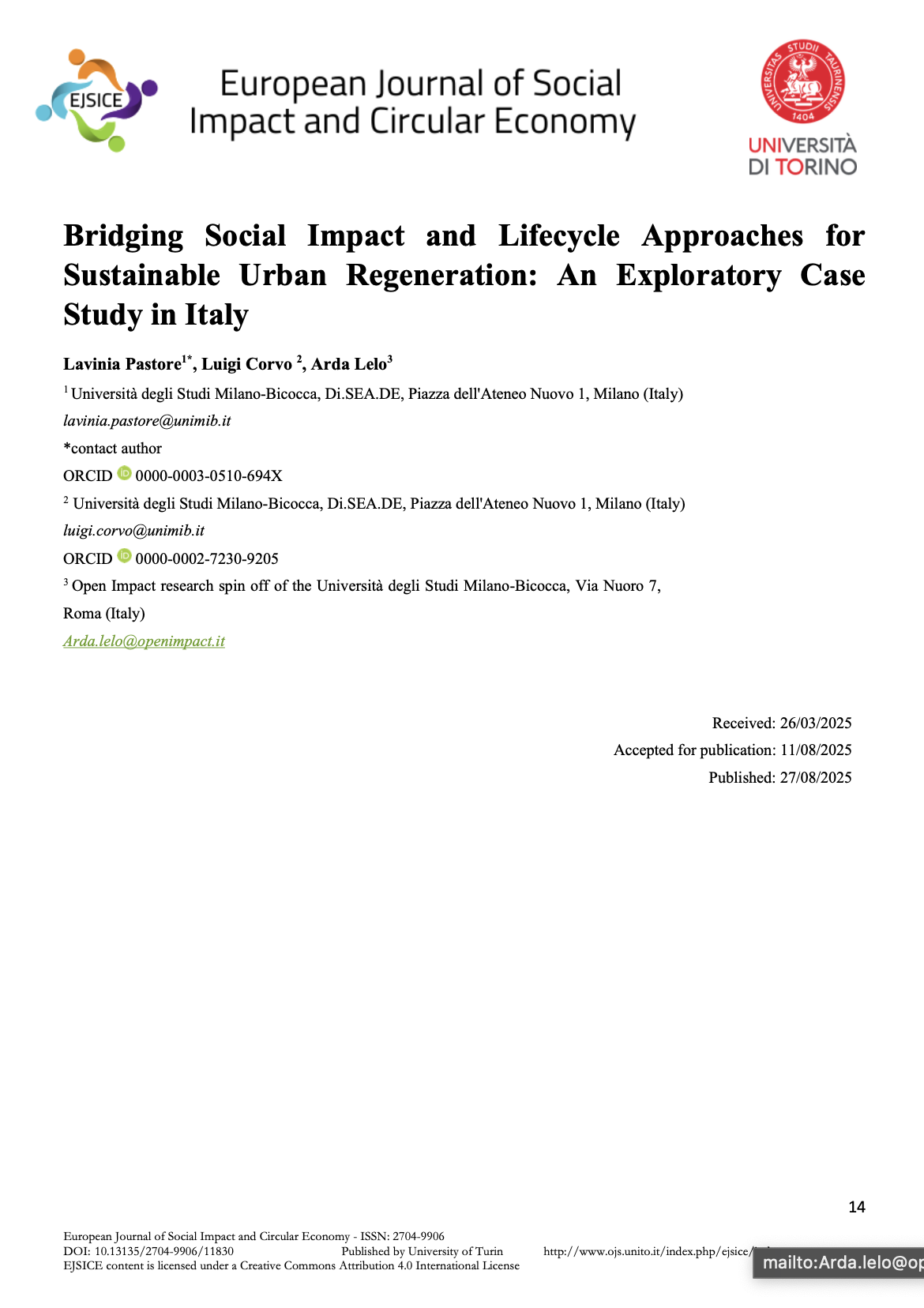Bridging Social Impact and Lifecycle Approaches for Sustainable Urban Regeneration: An Exploratory Case Study in Italy
DOI:
https://doi.org/10.13135/2704-9906/11830Keywords:
Impact Assessment, Stakeholders, Sustainability, life-cycle thinkingAbstract
This study explores how integrating social impact assessment (SIA) with lifecycle thinking can enhance urban regeneration outcomes by managing diverse stakeholder interests. A case study of a factory redevelopment in Tuscany, Italy, applies a novel analytical framework to map social, economic, and environmental value across project phases, examining patterns in outcome creation and stakeholder influence. The study advances impact assessment with an integrated framework capturing complex social value dynamics and enhancing social sustainability in urban interventions. The findings show that distinct value creation patterns and shifting stakeholder influence emerge across the project lifecycle. Proactive SIA application in early phases can reconcile divergent perspectives to maintain momentum. SIA integration with lifecycle assessment allows comprehensive understanding of value form interactions. The findings provide a structured approach for practitioners to anticipate conflicts, optimise value creation, and embed social sustainability across regeneration lifecycles. Integrated SIA adoption can improve urban intervention design and delivery. This approach enables effective stakeholder engagement promoting equitable benefit distribution, mitigating adverse impacts, and enhancing community resilience and well-being.
References
Ansell, C., Boon, W., Bryson, J., Crosby, B., Ferlie, E., Grotenbreg, S., Jukić, T., Kitchener, M., Meijer, A., Ongaro, E., Pluchinotta, I., Sancino, A., Sørensen, E., Torfing, J., Van Gestel, N., & Williams, H. (2024). Strategic management of the transition to public sector co-creation. Policy Press.
Arena, M., Azzone, G., & Bengo, I. (2015). Performance measurement for social enterprises. Voluntas: International Journal of Voluntary and Nonprofit Organizations, 26(2), 649–672. https://doi.org/10.1007/s11266-013-9436-8
Arli, D. I., & Cadeaux, J. (2014). Drivers of corporate community involvement and challenges in measuring its impact. Social Responsibility Journal, 10(1), 161–183. DOI: 10.1108/SRJ-10-2012-0116.
Arvidson, M., Lyon, F., McKay, S., & Moro, D. (2013). Valuing the social? The nature and controversies of measuring social return on investment (SROI). Voluntary Sector Review, 4(1), 3–18. DOI: 10.1332/204080513X661554.
Bailey, N. (2012). The role, organisation and contribution of community enterprise to urban regeneration policy in the UK. Progress in Planning, 77(1), 1–35. DOI: 10.1016/j.progress.2011.11.001.
Becker, H. A., & Vanclay, F. (2003). The international handbook of social impact assessment: Conceptual and methodological advances. Edward Elgar Publishing.
Ben-Akiva, M. E., Toledo, T., Santos, J., Cox, N., Zhao, F., Lee, Y.J., & Marzano, V. (2016). Freight data collection using GPS and web-based surveys: Insights from US truck drivers’ survey and perspectives for urban freight. Case Studies on Transport Policy, 4(1), 38–44.
Bhatnagar, A., Harri, A., Levanen, J., & Niinimaki, K. (2024). Exploring the role of social life cycle assessment in transition to circular economy: A systematic review. Resources, Conservation & Recycling, 207, 107702.
Biancone, P., Secinaro, S., Brescia, V., & Iannaci, D. (2019). The popular financial reporting between theory and evidence. International Business Research, 12(7), 45–56. DOI: 10.5539/ibr.v12n7p45.
Biondi, L., & Bracci, E. (2018). Sustainability, popular and integrated reporting in the public sector: A fad and fashion perspective. Sustainability, 10(9), 3112. DOI: 10.3390/su10093112.
Bottero, M., D’Alpaos, C., & Oppio, A. (2018). Multicriteria evaluation of urban regeneration processes: An application of PROMETHEE method in Northern Italy. Advances in Operations Research, 2018, Article 9276075. https://doi.org/10.1155/2018/9276075
Bryson, J. M., Barberg, B., & Crosby, B. C. (2024). The future of public service and strategy management-at-scale. Policy Quarterly, 20(1), 50–59. DOI: 10.26686/pq.v20i1.9052.
Bryson, J. M., Crosby, B. C., & Stone, M. M. (2015). Designing and implementing cross-sector collaborations: Needed and challenging. Public Administration Review, 75(5), 647–663. DOI: 10.1111/puar.12432.
Ciroth, A., Finkbeiner, M., Hildenbrand, J., Klöpffer, W., Mazijn, B., Prakash, S., Sonnemann, G., Traverso, M., Ugaya, C., & Vickery/Niederman, G. (2011). Towards a life cycle sustainability assessment: Making informed choices on products. eBook edition, UNEP/SETAC Life Cycle Initiative. www.lifecycleinitiative.org/wp-content/uploads/2012/12/2011%20-%20Towards%20LCSA.pdf
Clark, C., Rosenzweig, W., Long, D., & Olsen, S. (2004). Double Bottom Line Project Report: Assessing social impact in double bottom line ventures. University of California Berkeley.
Colantonio, A., & Dixon, T. (2009). Measuring socially sustainable urban regeneration in Europe. Oxford Institute for Sustainable Development.
Cordes, J. J. (2017). Using cost-benefit analysis and social return on investment to evaluate the impact of social enterprise: Promises, implementation, and limitations. Evaluation and Program Planning, 64, 98–104. DOI: 10.1016/j.evalprogplan.2016.11.008.
Corvo, L., Pastore, L., Mastrodascio, M., & Cepiku, D. (2022). The social return on investment model: A systematic literature review. Meditari Accountancy Research, 30(7), 49–86. DOI: 10.1108/MEDAR-05-2021-1307.
Crosby, B. C., & Bryson, J. M. (2005). Leadership for the common good: Tackling public problems in a shared-power world. John Wiley & Sons.
Das, P. K., & Uma Rao, S. P. (2013). Performance evaluation of socially responsible mutual funds using style analysis. Social Responsibility Journal, 9(1), 109–123. DOI: 10.1108/17471111311307840.
Dentoni, D., Bitzer, V., & Pascucci, S. (2016). Cross-sector partnerships and the co-creation of dynamic capabilities for stakeholder orientation. Journal of Business Ethics, 135(1), 35–53. DOI: 10.1007/s10551-015-2728-8.
Eisenhardt, K. M. (1989). Building theories from case study research. Academy of Management Review, 14(4), 532–550. DOI: 10.2307/258557.
Eisenhardt, K. M., & Graebner, M. E. (2007). Theory building from cases: Opportunities and challenges. Academy of Management Journal, 50(1), 25–32. DOI: 10.5465/amj.2007.24160888.
Emerson, J. (2003). The blended value proposition: Integrating social and financial returns. California Management Review, 45(4), 35–51. DOI: 10.2307/41166187.
Ferris, S. P., & Rykaczewski, K. P. (1986). Social investing and portfolio management. Business and Society, 25(1), 1–7. DOI: 10.1177/000765038602500101.
Flyvbjerg, B. (2006). Five misunderstandings about case-study research. Qualitative Inquiry, 12(2), 219–245. DOI: 10.1177/1077800405284363.
Freeman, R. E. (1984). Strategic management: A stakeholder approach. Pitman.
Geels, F. W. (2004). From sectoral systems of innovation to socio-technical systems. Research Policy, 33(6–7), 897–920. DOI: 10.1016/j.respol.2004.01.015.
Grieco, C., Michelini, L., & Iasevoli, G. (2015). Measuring value creation in social enterprises: A cluster analysis of social impact assessment models. Nonprofit and Voluntary Sector Quarterly, 44(6), 1173–1193. https://doi.org/10.1177/0899764014555986
Grana, F., Arena, M., & Busco, C. (2025). Addressing systemic challenges: The role of accounting and accountability practices. Accounting, Auditing & Accountability Journal. Advance online publication. https://doi.org/10.1108/AAAJ-12-2022-6175
Healey, P. (2006). Collaborative planning: Shaping places in fragmented societies. MacMillan International Higher Education.
Hinson, R. E., & Ndhlovu, T. P. (2011). Conceptualising corporate social responsibility (CSR) and corporate social investment (CSI): The South African context. Social Responsibility Journal, 7(3), 332–346. DOI: 10.1108/17471111111154491.
Jørgensen, A., Le Bocq, A., Nazarkina, L., & Hauschild, M. (2008). Methodologies for social life cycle assessment. The International Journal of Life Cycle Assessment, 13(2), 96–103. DOI: 10.1065/lca2007.11.367.
Lumpkin, G. T., Bacq, S., & Pidduck, R. J. (2018). Where change happens: Community-level phenomena in social entrepreneurship research. Journal of Small Business Management, 56(1), 24–50. DOI: 10.1111/jsbm.12379.
MacCallum, D., Moulaert, F., Hillier, J., & Vicari Haddock, S. (2009). Social innovation and territorial development. Ashgate Publishing.
Manring, N., West, P. C., & Bidol, P. (1990). Social impact assessment and environmental conflict management. Environmental Impact Assessment Review, 10, (3), 302–310.
Mill, G. A., & Holland, L. (2005). Socially responsible investment, information and the myth of underperformance. Social Responsibility Journal, 1(1/2), 91–97. DOI: 10.1108/eb045799.
Mills, A. J., Durepos, G., & Wiebe, E. (Eds.). (2010). Encyclopedia of case study research. Sage Publications. DOI: 10.4135/9781412957397.
Mitchell, R. K., Agle, B. R., & Wood, D. J. (1997). Toward a theory of stakeholder identification and salience: Defining the principle of who and what really counts. Academy of Management Review, 22(4), 853–886. DOI: 10.2307/259247.
Neville, B. A., Bell, S. J., & Whitwell, G. J. (2011). Stakeholder salience revisited: Refining, redefining, and refueling an underdeveloped conceptual tool. Journal of Business Ethics, 102(3), 357–378. DOI: 10.1007/s10551-011-0818-9.
Nicholls, A. (2018). A general theory of social impact accounting: Materiality, uncertainty and empowerment. Journal of Social Entrepreneurship, 9(2), 132–153. DOI: 10.1080/19420676.2018.1452785.
Nicholls, J. (2017). Social return on investment-development and convergence. Evaluation and Program Planning, 64, 127–135. DOI: 10.1016/j.evalprogplan.2016.11.011.
Obalola, M., & Adelopo, I. (2012). Measuring the perceived importance of ethics and social responsibility in financial services: A narrative-inductive approach. Social Responsibility Journal, 8(3), 418–432. DOI: 10.1108/17471111211247992.
Premyanov, N., Roma-Athanasiadou, E., Metta, J., Tsoniotis, N., Angelidou, M., & Tsolakis, A. C. (2024). Circular entrepreneurship via makerspaces towards fostering sustainable cities: A mixed-method approach with case studies. Journal of Circular Economy, 2(3), 1-31.
Ragozino, S. (2019). Navigating neo-liberal urbanism in the UK. Could a social entrepreneur be considered an activist planner?. In Calabrò, F., Della Spina, L., & Bevilacqua, C. (Eds.), New metropolitan perspectives (pp. 625–634). Springer International Publishing. DOI: 10.1007/978-3-319-92099-3_70.
Ravitch, S. M., & Carl, N. M. (2021). Qualitative research: Bridging the conceptual, theoretical, and methodological (2nd ed.). Sage Publications.
Saenz, C. (2020). A framework proposal for regional sustainability assessment: The case of the mining industry. Environmental Development, 34, 100513.
Saenz, C. S. (2021). A new mapping outcome method to measure social return on investment: A case study in Peru. Social Responsibility Journal, 17(4), 562–577. DOI: 10.1108/SRJ-04-2018-0097.
Sairinen, R. (2010). Special issue: Conflict mediation and social impact assessment. In Environmental conflict mediation and social impact assessment: Approaches for enhanced environmental governance? (Conference held on 14–15 February 2008 organised by Helsinki, Finland). Elsevier.
Sager, T. (2016). Activist planning: A response to the woes of neo-liberalism? European Planning Studies, 24, 1262–1280. DOI: 10.1080/09654313.2016.1168786.
Siggelkow, N. (2007). Persuasion with case studies. Academy of Management Journal, 50(1), 20–24. DOI: 10.5465/amj.2007.24160882.
Tate, C., O’Neill, C., Tran, N., Heron, L., Kee, F., Tully, M. A., ... & Hunter, R. F. (2023). The social return on investment of an urban regeneration project using real-world data: The Connswater Community Greenway, Belfast, UK. Cities & Health, 7(5), 699–718. https://doi.org/10.1080/23748834.2021.1929411
Toledo, T., Ben-Akiva, M., Santos, J., Cox, N., & Zhao, F. (2010). Urban freight tour models: State of the art and practice. Proceedings of the Commodity Flow Survey Workshop. Irvine, CA.
van der Veen, S., van Rechteren Limpurg, E., Asveld, L., & Chandrasekaran, S. (2025). Strengthening social life cycle assessment for a just bioeconomy: Insights from Namibia's bush-based value chains. Sustainable Production and Consumption, 45, 1-16.
Wang, Y., Yao, Y., Zhang, Y., & Xiang, L. (2022). A framework of stakeholder relationship analysis for an urban regeneration project based on social network analysis: A dynamic perspective. Journal of Urban Planning and Development, 148(4), 04022035. https://doi.org/10.1061/(ASCE)UP.1943-5444.0000861
Weidema, B. P. (2006). The integration of economic and social aspects in life cycle impact assessment. The International Journal of Life Cycle Assessment, 11(S1), 89–96. DOI: 10.1065/lca2006.04.016.
Wolch, J. R., Byrne, J., & Newell, J. P. (2014). Urban green space, public health, and environmental justice: The challenge of making cities ‘just green enough’. Landscape and Urban Planning, 125, 234–244. DOI: 10.1016/j.landurbplan.2014.01.017.
Yates, B. T., & Marra, M. (2017). Social return on investment (SROI): problems, solutions . . . and is SROI a good investment? Evaluation and Program Planning, 64, 136–144.
Yin, R. K. (2017). Case study research and applications: Design and methods (6th ed.). Sage Publications.
Zhou, J., Love, P. E., Matthews, J., Lavender, M., & Olatunji, O. (2018) Enhancing sustainability through understanding stakeholder perspectives on urban regeneration projects. Sustainability, 10(9), 3155.


 EJSICE has been approved for inclusion in DOAJ. The DOAJ listing of the journal is available at
EJSICE has been approved for inclusion in DOAJ. The DOAJ listing of the journal is available at  EJSICE is a member of
EJSICE is a member of  EJSICE is listed in the ANVUR (Italian National Agency for the Evaluation of Universities and Research Institutes) as a scientific journal in AREA 13 - Economic and Statistical Sciences and AREA 14 - Political and Social Sciences.
EJSICE is listed in the ANVUR (Italian National Agency for the Evaluation of Universities and Research Institutes) as a scientific journal in AREA 13 - Economic and Statistical Sciences and AREA 14 - Political and Social Sciences. 
